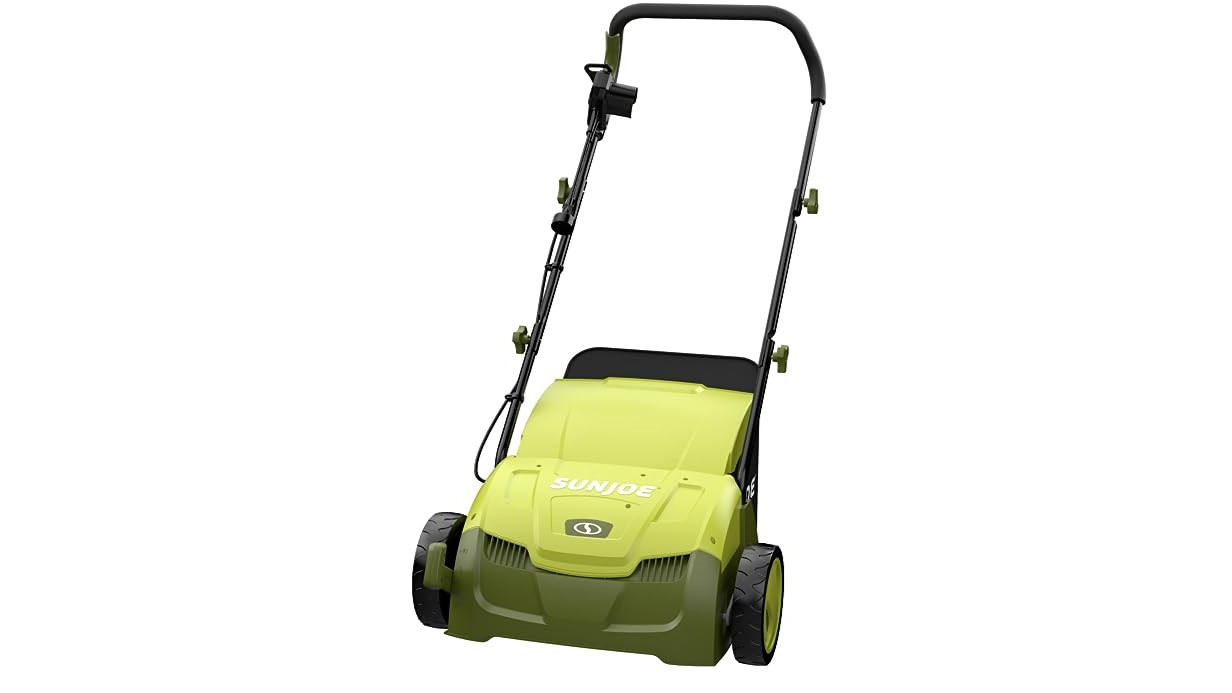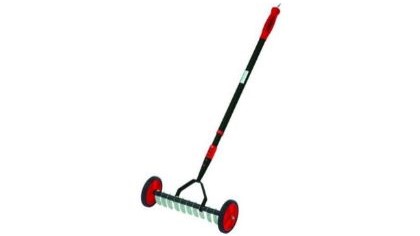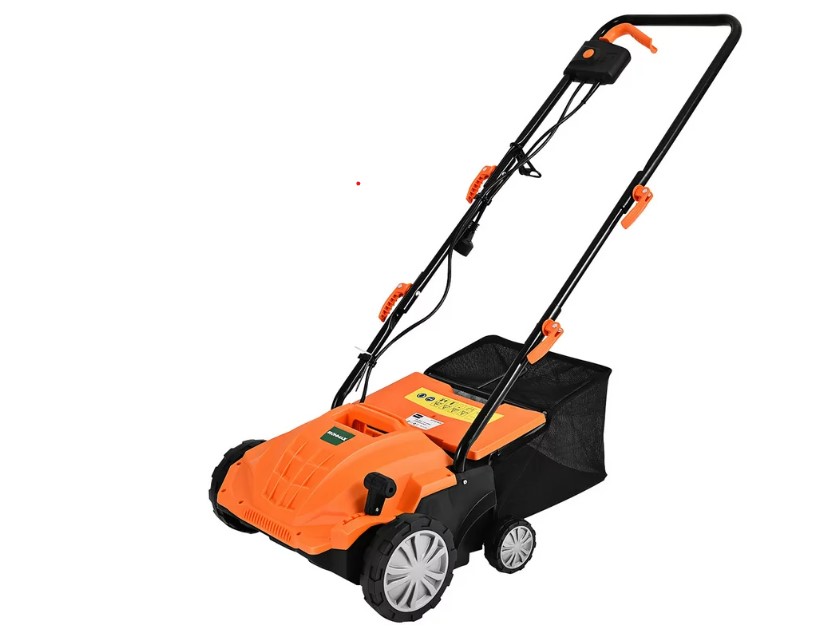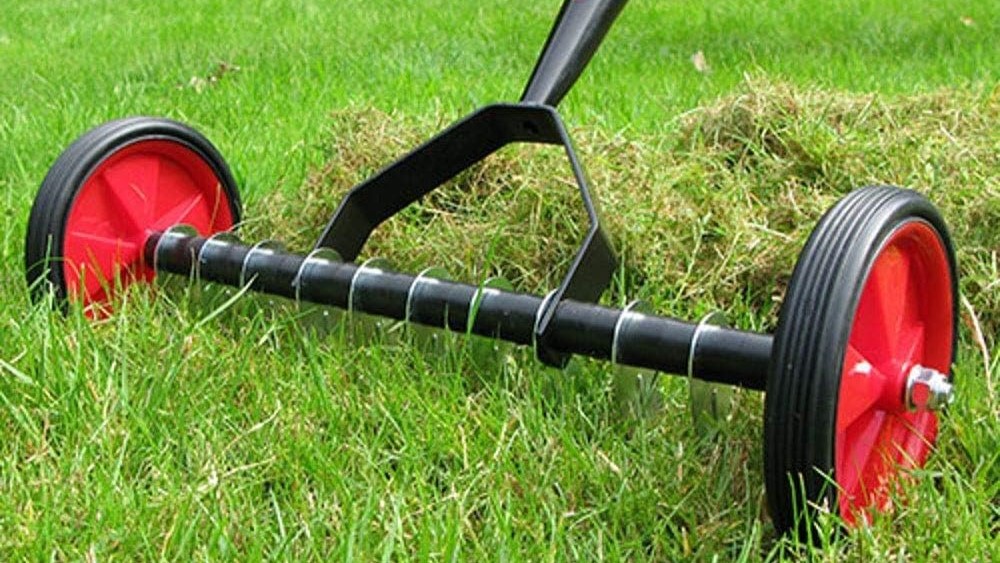It’s all too easy to allow a lawn to get out of hand. Dead cuttings, mosses and other natural detritus can build up between the grasses, locking out moisture and nutrients while messing up the lawn’s appearance.
Thatch – a natural layer of decaying grass between the roots and the visible stems – becomes especially troublesome when it builds up to more than a half-inch deep. Although a little thatch is good for the lawn, a thick layer can starve and dehydrate the roots.
To liberate lawns from excess thatch and other debris, we can use a powerful lawn tool known as a scarifier. This is any type of tool used for scarification, which means scoring the lawn using an array of hooked blades. Traditionally, scarification was done with a handheld scarifying rake, However, most present-day scarifiers are electric or gas-powered, pushable tools which resemble a walk-behind lawn mower.
When done properly, scarification can improve the flow of moisture and fertilizer to the roots of lawn grasses, by removing unhealthy thatch build-up (dethatching is an alternative way of achieving this). At the same time, the scarifier lifts away unhealthy grass and weeds such as mosses, allowing room for new, healthy grass to grow. In this guide, we’ll answer some of the key questions you might have about scarifiers, and take you through some of the best types of scarifier you can buy to use on your lawn.
3 of the best scarifiers you can buy in 2025

Simple, effective and affordably priced, the Sun Joe AJ801E gives you the capability to conveniently scarify OR dethatch your lawn – just install the right interchangeable attachment for your chosen lawn treatment, before you start. An 8-gallon collection bag gathers up plant matter while you scarify.

Is your lawn relatively small? And do you enjoy an outdoor workout? If you’ve answered ‘yes’ to both questions, then you should consider using a manual scarifier, such as this splendid example from Darlac. Scarifying manually is the best option to ensure fine control over the intensity of scarification. If you can see that the blades are ripping up too much grass, you can stop right away and adjust your approach.

Here’s another great household electricity powered option that combines scarifying and dethatching functionalities in one tool. With a 13-inch scarification width and 11-gallon collection bag, the Ironmax Lawn Scarifier and Dethatcher makes efficient work of scarifying small or medium lawns.
What is a scarifier?
A scarifier is a lawn tool used to rip out thatch and other unwanted plant matter from the lawn, creating better conditions for healthy lawn grasses to grow.
While there are various types of scarifier, all use an array of blades which dig into the soil and pull out thatch, roots and earth, scarring the lawn as they do so. The main differentiator between varieties of scarifier is how they are powered:
- Electric scarifiers are similar in appearance to a push lawnmower. Many of them are multi-purpose tools, also offering dethatching and other capabilities.
- Gas-powered scarifiers are usually walk-behind appliances, much like an electric scarifier. The big difference? They run off gas.
- Scarifying rakes are the traditional, handheld solution for scarification. Manual push scarifiers, which use a long handle and a scarifying attachment set on wheels, are more popular nowadays.
- Towed scarifiers can be hitched to the rear of a zero-turn lawn mower, tractor or ATV, for effortless scarification.
Please be aware that lawn scarifiers are not the only type of tool called a scarifier. There are also scarifiers intended for scarifying concrete, not grass. Some retailers list these heavier-duty scarifiers in the same part of their website as lawn scarifiers – so double-check to ensure you’re not buying a piece of construction machinery to use on the lawn!
FAQs
Is scarifying the same as aerating?
Scarification and aeration are two different lawn care processes. The primary goal of scarification is to remove thatch and other organic matter from the lawn. Aeration means poking holes in the lawn to improve air flow and drainage.
However, scarification and aeration can sometimes both be done in the same action. Scarifiers tend to leave holes (or ‘scars’) in the ground, and as such, they have an aerating effect. However, if you want to aerate a lawn that doesn’t need to be scarified, the healthier solution would be to use a purpose-made aerator that will less severely impact the grass.
When should you scarify your lawn?
Lawn experts differ in their opinions on when to scarify a lawn. Some recommend scarifying once or twice per year. The right time of year to do this will depend on your local climate. In most parts of the US, scarifying in spring or early fall is generally recommended. Scarifying at other times of year may limit regrowth, leaving the lawn thin and patchy for a long period.
With that said, some experts argue that scarification shouldn’t be done at all, as it may harm the lawn more than it helps it. The scarification process inevitably does short-term damage to the lawn, and it may also decrease the lawn’s biodiversity. Think carefully about when to scarify your lawn – and if you go ahead, scarify at a time when the grasses will get a warm-weather window of time for regrowth, immediately after scarification.
Is scarifying better than raking?
Scarifying and raking are sometimes the same thing, as a scarifying attachment can be added to a rake handle for the purpose of scarification.
However, rakes are more typically used for the less intensive lawn care processes of dethatching (to remove some thatch) and lawn raking (to remove moss and debris such as fallen leaves). Using a rake for scarification is not uncommon, but it can be tough, physical work.
If we’re assuming ‘raking’ means ‘dethatching’ or ‘lawn raking’, then it will have a different effect to scarification using a scarifier. Scarification will mean more thatch is lifted from the lawn, and the lawn will be dug up to a greater extent.
Neither scarifying nor lawn raking is better than the other. These two distinct actions are both ideal for achieving a particular end result.
What is the difference between a scarifier and a dethatcher?
A scarifier uses an array of hooked blades to deeply scar the lawn, pulling up thatch and other plant matter as it goes. Meanwhile, a dethatcher also pulls up thatch – but less of it.
In place of a scarifier’s hooks, a dethatcher uses long metal tines that leave most of the grass and soil unaffected.
Often, dethatchers and scarifiers are sold as the same all-in-one tool. You simply swap between attachments to do the different tasks (and sometimes other jobs, such as aeration).
For most reasonably healthy lawns, dethatching could be a better choice than scarification, as it will do less collateral damage to the lawn. However, if your lawn has gotten really out of control, or if you need the lawn to be HOA-perfect, there might be no choice but to scarify.

